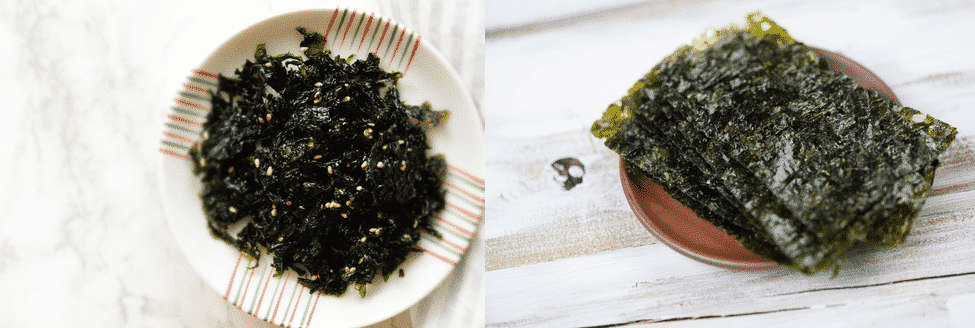
If you want to follow a healthy lifestyle, opting for seaweed is the right choice. Seaweed is known as the algae that grow in seas and have become a source of food for marine life. The seaweed color ranges from green to red and brown to black. Generally, it grown along the rocky shores and is readily consumed in China, Korea, and Japan.
For the most part, seaweed is a versatile food item and can be used in salads, stews, soups, sushi rolls, and smoothies. The seaweed is full of nutrition which means you can use a little amount for your recipes. That being said, gim vs. nori is a common comparison and we are sharing everything you need to know about these two seaweeds!
Gim vs Nori
Gim
To begin with, gim is the edible seaweed that is widely used in Korean cuisine. It’s safe to say that gim is widely cultivated and is known to be one of the popular seaweeds in Korea. Gim is generally consumed as a side dish. On the other hand, the dried and sheet form of gim is suitable for making rice rolls (they are known as gimbap in Korea).
Gim is rich in riboflavin, protein, vitamin A, vitamin B6, thiamine, and vitamin B12. In addition, it has higher mineral salt content along with other amino acids. That being said, it’s an extremely nutritious seaweed. Some people also cut the sheeted gims into squares and fry them to make fritters. As far as the rice rolls are concerned, gim is used in its dried form.
Some people also call it kim and is available in different variants. The original gim is available in an unflavored version but you can also buy the salted and sesame oil-toasted gim. The toasted and salted gim is suitable for wrapping the rice balls or for topping the soups. In some cases, it’s served with potato chips since it has an amazing flavor and has a crispy texture.
Sure, it’s famous in Korea but it’s also consumed in Ireland, Wales, and the Philippines. Gim is common among women who have given birth since it’s healthy and full of nutrition. The intriguing thing is that naturally grown gim is insufficient to meet the customers’ demand which is why it’s grown at a commercial level.
There are different types of gim available in the market, such as dol gim, jaerae gim, parae gim, and gim for gimbap. The dol gim is available with rough texture, holes, and fragrance. As for jaerae gim, it is roasted with salt and sesame oil. Lastly, parae gim is a combination of green algae and gim and is available in a dried form.
Nori
Nori is the dried seaweed that is used in Japanese cuisine. It is edible and is made from red algae. The seaweed has a strong and unique flavor which makes it suitable for wrapping rice balls and sushi. These dried sheets are made through rack-drying and shredding (the process is similar to papermaking). Generally, it is available in grocery stores and Japanese stores.
Nori can absorb water and lead to degrading which is why you should use desiccant for ensuring proper storage. In addition to wrapping, it is suitable for flavoring soups and noodles (it can be sued as garnishing as well). Before using it, you have to toast it but the pre-toasted versions are available as well. For the most part, it’s toasted in soy sauce or similar sauces.
Some people also confuse it with aonori but it’s a different alga that is used as herb for salads and other Japanese meals. As far as nutrition is concerned, nori has a higher nutrition count because it has carbohydrates, protein, folate, vitamin C, vitamin A, and riboflavin. Also, it has become a suitable source of zinc, iron, and niacin.
In addition to the Japanese nori, the Korean nori is also known as gim (yes, it’s true). The nori paste is extremely popular with which nori is boiled with various seasonings and soy sauce. As for this nori paste, it can be topped on the rice. Nori is pretty old and it has been an important part of Japanese cuisine for a long time (since 701AC).
